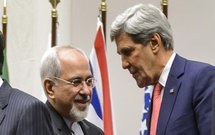 The nuclear deal agreed between the six world powers and Iran to curb its nuclear programme that entered into force on January 20, 2014 is progressing well.
The nuclear deal agreed between the six world powers and Iran to curb its nuclear programme that entered into force on January 20, 2014 is progressing well.
The latest developments include Iran’s proposal to redesign its Arak heavy water reactor, a positive move by Iran to wards resolving one of the most contentious issues involving the deal. Iran has also announced that it is drafting a comprehensive account of its past nuclear activities. This is part of the transparency measures required to be undertaken by Iran. IAEA, which has been assigned the responsibility of verifying Iran’s compliance, has also reported positively, stating that Iran so far has been undertaking the agreed steps to curb its nuclear program me. Reciprocating Iran’s positive moves, the US has started releasing Iran’s frozen assets. Most importantly, New York has been chosen as the venue for the next round of expert - level talks to be held on 5-9 May, 2014. The fact that it would be for the first time in decades that such talks would be held on the US soil, speaks volumes of the anticipated breakthrough.
As far as Iran is concerned, the crippling economic sanctions and consequent election of a relatively moderate Hassan Rouhani to the post of president explain its readiness to grab the deal. A careful analysis of the decade - long Iranian nuclear problem reveals that this stalemate was largely due to the US policy of not engaging Iran. Now that Obama has decided to engage Iran, it would be useful to find out the rationale for the same.
One may argue that the new US policy of engaging Iran might be a result of Obama’s effort to justify his Nobel Peace Prize. Otherwise, he wouldn’t have gone extra mile to oppose his own Congressmen when they threatened to pass a new sanctions bill against Iran. To placate such opposing voices in the Congress, the White House had made public a summary of the technical details of the nuclear deal disclosing part of its implementation plan. Another reason might be related to mitigating the popular perception of US as a declining power, which was further accentuated by the Iran-US standoff. Solving a chronic problem, even at the cost of antagonising long term all ies such as Israel and Saudi Arabia, might prove helpful in the much needed image makeover.
Still another reason could be that Obama is now somehow convinced that Iran is not serious about building a nuclear bomb, as it has often declared. Otherwise the nuclear deal would have never respected Iran’s red line, i.e. the right to enrich uranium. While none of these reasons can be ruled out completely, a relatively more plausible explanation could be one related to the prevailing situation in the Middle East, where the US is currently facing multiple challenges. For the past few years the Middle East has been in constant turmoil and afflicted by a number of issues which could not be effectively resolved through the earlier US policy of isolating Iran. It is not a coincide nce that the Iran nuclear deal came at a time when Western powers were striving hard to negotiate a solution to the Syrian problem. This deal also came at a time when NATO forces are about to withdraw from Afghanistan and the US has been contemplating its gains, if any, in Iraq. Similarly, it can definitely not be a coincidence that the deal has been struck when Obama badly needs to focus on his stated ‘pivot to Asia’ policy, in which he cannot make much headway unless the Middle East problems are eased.
Nevertheless, no one, beside the negotiating parties, actually knows what transpired behind the closed doors. Russia has reportedly denied any secret agreement as far as Syria is concerned. Similarly, the US has also denied the involvement of any secret agreement.Despite these denials, the possibility of linking the nuclear deal with other Middle East issues during the negotiations cannot be completely ruled out. The way Iran has been pushing for the deal and projecting the same in its domestic constituency illustrates its new found confidence. Does that suggest that there is something in this deal which tilts the balance in Iran’s favour? If so, it could be an acknowledgment by the US of Iran’s specific role in the Gulf region.
It may not be difficult to explain how Iran can play a constructive role in finding a solution to the Syrian problem. Similarly, it can also play a constructive role in the stability of Afghanistan and Iraq. If the US is convinced that these problems could be solved much easily with the help of Iran, then the opposition from any quarter, internal such as from the Congress, or external such as from Saudi Arabia and Israel, may not hold much ground. And if that is so, then the Iran nuclear deal might prove to be an instrument to solve the current Middle East dilemma of the US. Or at least this is how Obama might have calculated before entering into the nuclear deal with Iran.
Dr. Asif Shuja, Research fellow at Indian Council of World Affairs, New Delhi
Courtesy : Indian Council of World Affairs